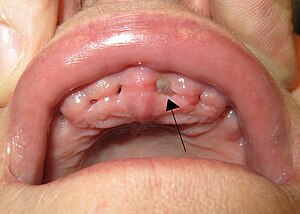Alveolar osteitis, also known as dry socket, is inflammation of the alveolar bone (i.e., the alveolar process of the maxilla or mandible). Classically, this occurs as a postoperative complication of tooth extraction.
Alveolar osteitis usually occurs where the blood clot fails to form or is lost from the socket (i.e., the defect left in the gum when a tooth is taken out). This leaves an empty socket where bone is exposed to the oral cavity, causing a localized alveolar osteitis limited to the lamina dura (i.e., the bone which lines the socket). This specific type is known as dry socket and is associated with increased pain and delayed healing time.[1]
Dry socket occurs in about 0.5–5% of routine dental extractions,[2][3][4] and in about 25–30% of extractions of impacted mandibular third molars (wisdom teeth which are buried in the bone of the lower jaw and which erupt during adulthood).[1] If it is going to occur, the pain of dry socket may appear as early as three days following surgery; however, a patient who has gone a full week without experiencing this kind of pain is highly unlikely to develop it.[5]
| Alveolar osteitis | |
|---|---|
| Other names | Dry socket, fibrinolytic alveolitis |
 | |
| Alveolar osteitis of a socket after tooth extraction of all maxillary teeth; note lack of blood clot in socket and exposed alveolar bone | |
| Specialty | Dentistry |
https://en.wikipedia.org/wiki/Alveolar_osteitis
No comments:
Post a Comment